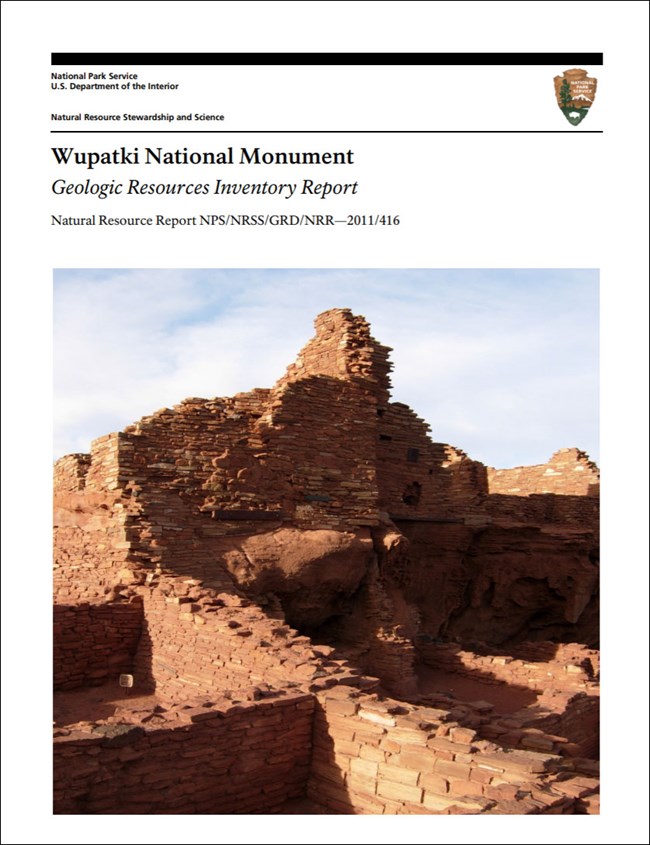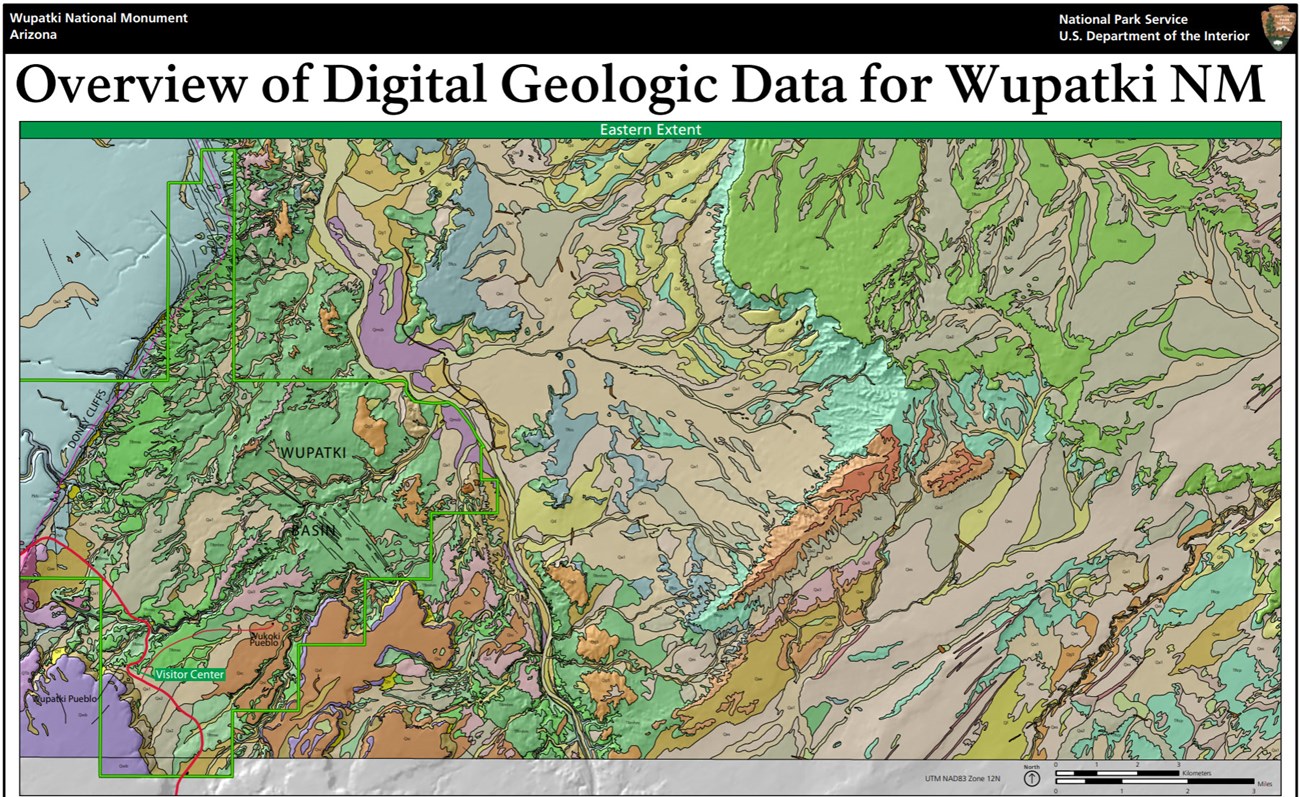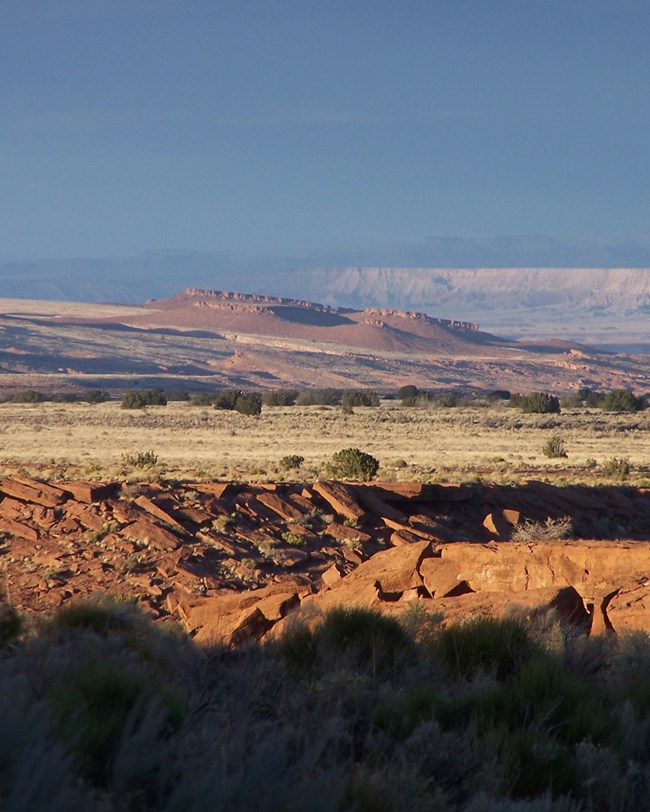Last updated: March 18, 2024
Article
NPS Geodiversity Atlas—Wupatki National Monument, Arizona
Geodiversity refers to the full variety of natural geologic (rocks, minerals, sediments, fossils, landforms, and physical processes) and soil resources and processes that occur in the park. A product of the Geologic Resources Inventory, the NPS Geodiversity Atlas delivers information in support of education, Geoconservation, and integrated management of living (biotic) and non-living (abiotic) components of the ecosystem.

Introduction
Wupatki National Monument is located about 42 km (26 mi) north of Flagstaff in Coconino County, Arizona. Proclaimed on December 9, 1924, Wupatki contains approximately 14,334 hectares (35,422 acres) and preserves more than 2,700 archeological sites distributed across the Painted Desert landscape on the southwestern Colorado Plateau. Sites mostly date to the 12th and 13th centuries and range in size from lithic and sherd scatters, to small single-room field houses, to several large, prominent free-standing pueblos containing 50 to 100 rooms. The monument was originally authorized in 1924 to protect the Citadel and Wupatki Pueblos that were built by a culture archeologists refer to as the Northern Sinagua, but subsequent boundary adjustments over the years have encompassed additional pueblos (Graham 2011). The region of Wupatki was home, at various times, to several American Indian tribes and preserves a tangible record of clan migrations and extensive trading practices through the centuries.
Geologic Setting
The geologic landscape of Wupatki National Monument predominantly consists of lower Permian (299–270 million years ago) and Lower Triassic (252–245 million years ago) sedimentary rocks. In eastern Wupatki, red sandstone and siltstone exposures of the Triassic Moenkopi Formation stand in vivid contrast to the gray limestone outcrops in western Wupatki. The Northern Sinagua people primarily utilized the reddish sandstone of the Moenkopi Formation as principal building blocks for their pueblos. In the western portion of Wupatki, Permian-age strata of the Kaibab and Toroweap Formations constitute the extensive Antelope Prairie and form cliffs and ledges of calcareous sandstone and cherty limestone. Pliocene and Pleistocene-age basaltic lava flows occur as erosion-resistant caprock on several mesas in the western and southern areas of the monument, sourced from volcanic eruptions in the San Francisco volcanic field located south of the monument (Graham 2011). The major geologic structure in Wupatki is the Black Point Monocline, a northeast–southwest-trending asymmetric fold that bisects the monument and separates Permian units from younger Triassic strata.
Regional Geology
Wupatki National Monument is a part of the Colorado Plateaus Physiographic Province and shares its geologic history and some characteristic geologic formations with a region that extends well beyond park boundaries.
- Scoping summaries are records of scoping meetings where NPS staff and local geologists determined the park’s geologic mapping plan and what content should be included in the report.
- Digital geologic maps include files for viewing in GIS software, a guide to using the data, and a document with ancillary map information. Newer products also include data viewable in Google Earth and online map services.
- Reports use the maps to discuss the park’s setting and significance, notable geologic features and processes, geologic resource management issues, and geologic history.
- Posters are a static view of the GIS data in PDF format. Newer posters include aerial imagery or shaded relief and other park information. They are also included with the reports.
- Projects list basic information about the program and all products available for a park.
Source: Data Store Saved Search 3203. To search for additional information, visit the Data Store.
A NPS Soil Resources Inventory project has been completed for Wupatki National Monument and can be found on the NPS Data Store.
Source: Data Store Saved Search 3228. To search for additional information, visit the Data Store.
Related Articles
Wupatki National MonumentNational Park Service Geodiversity Atlas
The servicewide Geodiversity Atlas provides information on geoheritage and geodiversity resources and values within the National Park System. This information supports science-based geoconservation and interpretation in the NPS, as well as STEM education in schools, museums, and field camps. The NPS Geologic Resources Division and many parks work with National and International geoconservation communities to ensure that NPS abiotic resources are managed using the highest standards and best practices available.
For more information on the NPS Geodiversity Atlas, contact us.


